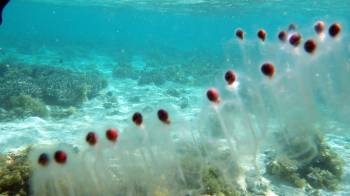Life History & Behaviour

|
|
|
Aggregate generation of Pegea Confoederata
(photo by Helen Twaddle, Heron Island)
|
Pegea confoederata respond very quickly to increases in food availability (phytoplankton blooms) and this is one main adaptation salps have made for a pelagic lifestyle. Salps in general exhibit impressively rapid growth rates and reproduction during these times of high phytoplankton (Alldredge and Madin 1982). This is possible because Pegea confoederata has such a small amount of organic matter for its' overall size, so has relatively low metabolic needs and can grow and reproduce very quickly (Hamner et al. 1975). In extreme situations, when food is very abundant and competition is very low, large densities of salps can occur. Salp densities can reach up to 7000 individuals per m3 for several hundred km (Deevey 1952, Alldredge and Madin 1982).
|